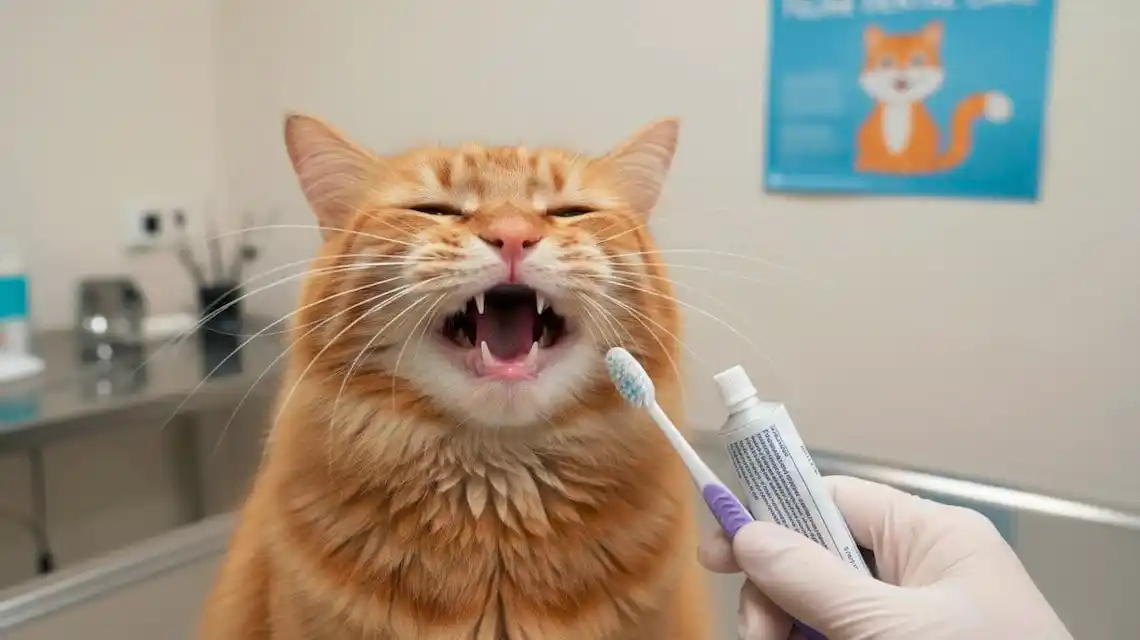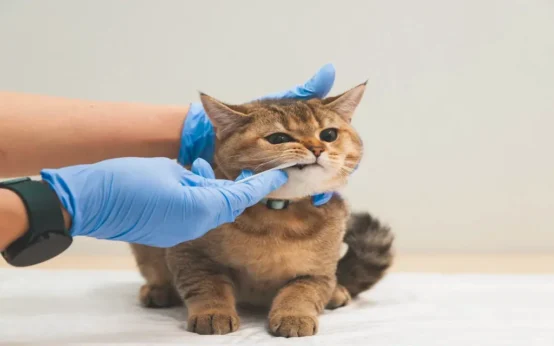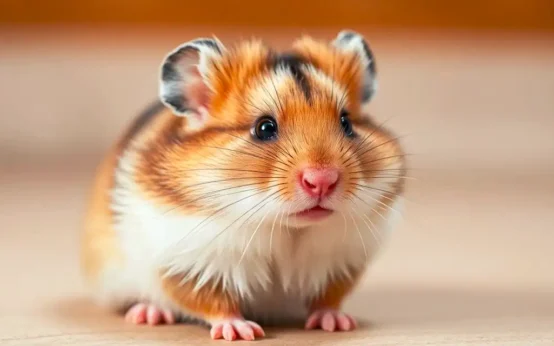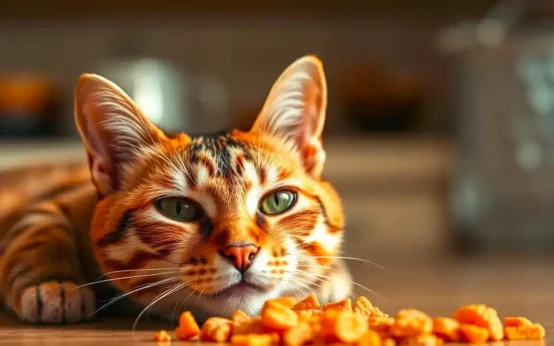Cats rarely complain about mouth pain. They hide it well. That is why dental health for cats matters more than most owners realize. A tiny layer of sticky plaque can turn into hard tartar, sore gums, and trouble eating. Small daily steps prevent big problems.
This guide keeps it simple. You will learn early signs to watch for, what a healthy mouth looks like, and how to build an easy home routine. You will also see what happens during a vet cleaning, why anesthesia is used, and how to keep your cat comfortable after a procedure. Short answers to common questions are at the end.
You do not need to be perfect. Cats respond well to calm, steady habits. By the time you finish, you will have a clear action plan that fits real life. Ready for an easy start today? A one-minute training routine closes the post.
Why dental health for cats matters: signs, risks, and a healthy mouth checklist
Plaque is a sticky film of bacteria. It builds on teeth every day. If it is not removed, it hardens into tartar. Tartar pushes against the gums and traps more bacteria. That cycle causes sore, swollen tissue and can damage the structures that hold the teeth.
Gum disease begins as gingivitis, which means inflamed gums. Left alone, it can move deeper into the tissues. Then it becomes periodontal disease, which can loosen teeth and hurt with every chew.
Mouth pain changes how a cat eats and acts. Some cats avoid crunchy food. Others swallow kibble whole. You may notice a head tilt when chewing, or a sudden drop of food from the mouth. Pain also affects mood. A friendly cat might hide or hiss more. Grooming can slow down, since licking hurts.
Dental disease does not stay in the mouth. Bacteria can enter the bloodstream and may affect organs over time. That risk is higher in older cats or those with other health issues. Early care improves comfort, appetite, and energy.
Healthy-mouth checklist:
- Pink gums without swelling
- No strong mouth odor
- Teeth with little to no yellow or brown buildup
- Normal eating and grooming
- No drooling or pawing at the face
Common cat dental problems explained
- Gingivitis: inflamed, red gums where teeth meet the gumline. Often reversible with cleaning and home care.
- Periodontal disease: damage to the tissues that support the teeth. This can lead to loose teeth and bone loss.
- Tooth resorption: the body breaks down parts of a tooth. It is painful and common in cats. Treatment often means extraction.
- Stomatitis: widespread inflammation that can affect the whole mouth. It is very painful and needs a tailored vet plan.
Plaque is soft and easy to wipe away. Tartar is hard and bonds to the tooth surface. Cats often hide pain, so a change in appetite or behavior may be your only clue.
Early warning signs of dental problems in cats
- Bad breath that is strong or sweet
- Drooling or lip licking
- Red, puffy, or bleeding gums
- Yellow or brown buildup on teeth
- Pawing at the mouth
- Dropping food or chewing on one side
- Swelling on the face or jaw
- Mood changes, hiding, less play
- Less grooming or a messy coat
Try a quick home check once a week. Small changes caught early are easier to fix.
What a healthy cat mouth should look, smell, and feel like
Healthy gums look pink, not fiery red. There should be no strong odor. Teeth should look clean with little to no buildup. Eating, grooming, and play should look normal. No drooling, no flinching.
Safe check routine: lift your cat’s lip gently. Look for 3 to 5 seconds. Praise and treat. Stop if your cat resists. Short and calm beats long and stressful.
What happens if you ignore dental care
Problems can build slowly, then all at once. Pain can become constant. Teeth may loosen or break. Bacteria can cause infections and affect appetite. Cats might eat less, lose weight, and have lower energy. There is also a chance that oral bacteria may affect organs like the heart and kidneys over time, especially in older cats or those with chronic disease. The bottom line is quality of life and lifespan can suffer if dental pain goes on. Early care keeps your cat comfortable and active.
At-home care for dental health: simple steps that actually work
You do not need to brush perfectly every day. Consistency wins. Aim for calm, brief sessions. Focus on the outside surfaces of the teeth, where plaque collects most. Add approved products that help.
Look for the VOHC seal on dental products. VOHC stands for Veterinary Oral Health Council. That seal means the product met standards for reducing plaque or tartar. It is a helpful shortcut in the pet aisle.
Start slow. Pair handling with treats. Use cat toothpaste that your cat likes. A flavored gel or a wipe is better than nothing. If brushing is tough, use a mix of tools until it gets easier.
Keep a simple routine. Two or three short sessions per week can still help. Daily is best if your cat accepts it. Add dental treats or a VOHC dental diet for extra help, but do not skip brushing if your cat allows it.
Mini weekly schedule:
- Monday: 1-minute brush or wipe session
- Wednesday: Dental gel or rinse, plus a dental treat
- Friday: 1-minute brush or wipe session
- Sunday: Quick lip lift check, note any redness or odor
How to brush a cat’s teeth step by step
- Touch and treat. Gently touch cheeks and lips with your finger. Reward right away.
- Add taste. Place a pea-sized drop of cat toothpaste on your finger. Let your cat lick it. Praise.
- Finger brush stage. Use a finger brush or gauze. Rub the outer surfaces of the back teeth in small circles. Count to ten.
- Upgrade brush. Switch to a small, soft pet brush. Hold bristles at a 45-degree angle to the gumline.
- Focus zones. Brush the outer surfaces of upper back teeth first. That area builds plaque fastest.
- Keep it short. Thirty to sixty seconds is enough. End with a tasty treat.
- Stay gentle. Never use force. If your cat pulls away, stop and try again later.
Cat-safe toothpaste, brushes, gels, and wipes
- Never use human toothpaste. Xylitol can be dangerous for cats.
- Finger brushes: easy to control, good for training.
- Small bristle brushes: reach better once your cat accepts brushing.
- Dental gels: coat the teeth and gumline, useful when brushing is tricky.
- Wipes: remove soft plaque on the surface, quick and simple.
Pick flavors your cat enjoys, like poultry or fish. Look for the VOHC seal when possible to improve results.
Dental treats and diets: do they help?
Some treats and diets use texture and shape to scrub plaque while the cat chews. These can help reduce buildup, but they are add-ons. Brushing does more for the gumline.
Treats add calories. Adjust meals to avoid weight gain. For stronger support, ask your vet about VOHC dental diets that are made to reduce plaque and tartar.
When brushing is not possible: real-world alternatives
Try dental wipes, chlorhexidine gels or rinses, and water additives with good evidence. Daily chew toys made for cats can help, as long as they are not too hard. Skip bones, string, or hard objects that can chip teeth or cause injury. Keep training short and kind. Many cats learn to accept some brushing over time, especially with tasty rewards.
Vet visits and professional cleanings: what to expect and when to go
Kittens get their mouths checked during vaccine visits. Adult cats should have yearly dental exams. Seniors and cats with dental disease often need checks twice a year. Your vet can set a plan that matches your cat’s age and health.
A full dental cleaning needs anesthesia. That allows safe scaling above and below the gumline and full mouth X-rays. Cats do not hold still for that kind of care when awake. Anesthesia also reduces stress and pain.
Clinics use safety steps to protect your cat. These include a pre-exam, bloodwork, IV fluids, and close monitoring. Costs vary by region, and by the level of care your cat needs. Expect your cat to be sleepy after the procedure. Most eat later that day or the next morning.
How often cats need dental exams and cleanings
Most healthy adult cats need a dental exam once a year. Seniors or cats with known dental disease benefit from twice-yearly exams. Some breeds and individuals build tartar faster and need more frequent cleanings. Kittens get mouth checks during vaccines to confirm normal tooth growth and bite.
What happens during a professional cleaning (under anesthesia)
- Pre-exam and bloodwork to assess anesthesia risk
- Anesthesia induction and airway support
- Continuous monitoring for heart rate, breathing, oxygen, and temperature
- Full mouth X-rays to find problems under the gumline
- Scaling above and below the gumline to remove plaque and tartar
- Polishing to smooth tooth surfaces
- Probing and charting each tooth
- Extractions if teeth are painful, loose, or damaged
- Pain control during and after the procedure
Your vet will discuss findings, next steps, and home care after treatment.
Anesthesia safety for cats: key questions to ask your vet
- What monitoring do you use during anesthesia?
- How will you manage pain before and after the procedure?
- Will my cat have warming support to maintain body temperature?
- Will my cat receive IV fluids?
- Who watches my cat during recovery, and for how long?
- Is pre-anesthetic bloodwork included, and how do you tailor the plan for seniors or cats with other health concerns?
These questions help you understand the process and build confidence in your cat’s care team.
Aftercare and recovery: feeding, meds, and comfort
Set up a quiet room at home. Offer soft food if your vet advises it. Give pain meds and antibiotics exactly as prescribed. Watch for bleeding, swelling, drooling, or poor appetite. Call the clinic if you are worried or if your cat refuses food for more than a day.
If extractions were done, ask when to restart brushing. Many vets suggest waiting until the mouth has healed. Use gels or wipes only if your vet approves. Keep the routine calm, short, and positive.
FAQs: quick answers about dental health for cats
Is bad breath normal for cats?
No. A mild food smell is normal. Strong, sour, or sweet breath often points to dental disease or other health issues. If your cat’s breath changes or worsens, schedule a vet check.
Does dry food clean a cat’s teeth?
Most kibble does little for plaque. Special dental diets can help because of their texture and design. Brushing and VOHC products work best for the gumline and long-term control.
Do indoor cats still need dental care?
Yes. Indoor life does not prevent plaque from forming. Dental disease is common in indoor cats. Keep a simple routine and plan regular dental exams.
How can I help a senior cat with dental disease?
Go gentle and keep sessions short. Offer softer foods if chewing is hard. Warm wet food to boost aroma and appetite. Book more frequent checkups and follow a pain control plan. Your vet can tailor care for kidney disease, thyroid issues, or other conditions.
What if my cat refuses any mouth handling?
Try slow desensitization with high-value treats. Use calming pheromones and keep sessions under a minute. A towel wrap can help with safety, if your vet shows you how. Use wipes or gels as a bridge. Ask your vet or a behaviorist for hands-on guidance.
If you ever feel unsure about dental health for cats, set a vet appointment. A quick exam beats months of quiet pain.
Conclusion
Healthy teeth support appetite, grooming, and play. The big three are simple: daily or near-daily home care, watch for early signs, and regular vet exams with cleanings when needed. Small, steady actions add up to real comfort.
Action plan:
- Choose a VOHC-approved toothpaste, gel, or wipe.
- Start 1-minute training today, touch cheeks and reward.
- Set a weekly lip-lift check on your calendar.
- Book your cat’s next vet dental exam.
Cats feel and act better with a pain-free mouth. Build a routine that fits your life, and stick with it. You will see more comfort, more energy, and more happy years with your favorite whiskered friend.
Related post:
How Much Does It Cost to Make Homemade Cat Food?
What to Do When Your Cat Runs Away
Dental Health for Cats FAQs:
How common are dental problems in cats?
Very common. Most cats develop some level of periodontal disease by age three. Plaque hardens into tartar, gums inflame, and infection can follow.
What are early signs of dental disease?
Bad breath, red or swollen gums, yellow or brown tartar, pawing at the mouth, drooling, and dropping food. Behavior changes count too, like hiding or irritability.
How often should I brush my cat’s teeth?
Daily is best, three to four times a week still helps. Use a cat-safe toothpaste, never human toothpaste.
What’s the right way to brush a cat’s teeth?
Go slow and make it positive. Lift the lip, angle the brush to the gumline, use small circles, focus on outer surfaces, and reward after. Aim for 30 to 60 seconds.
Do dental treats or diets replace brushing?
No. They help reduce plaque, but they don’t clean like brushing. Look for VOHC-accepted products to support daily care.
Is dry food better for teeth than wet food?
Not by default. Most kibble shatters and does little for plaque. Some dental diets have special kibble that helps. Ask your vet for options.
How often do cats need professional cleanings?
Most healthy adult cats need a cleaning every 1 to 2 years. Cats with periodontal disease, resorptive lesions, or stomatitis may need them more often.
Are anesthesia dental cleanings safe?
Yes, with proper screening. Vets do exams and lab work, then tailor anesthesia to your cat’s health. The benefits outweigh the risks for most cats.
What happens during a professional dental cleaning?
Full exam, scaling above and below the gumline, polishing, dental X-rays, and extractions if needed. X-rays catch hidden root problems that you can’t see.
What causes bad breath in cats?
Usually plaque and gum disease. Other causes include oral ulcers, tooth resorption, kidney disease, diabetes, or oral tumors. Persistent odor needs a vet visit.
What are tooth resorption and stomatitis?
Tooth resorption is when the tooth breaks down from within. Stomatitis is severe mouth inflammation that causes intense pain. Both need veterinary care.
How can I tell if my cat’s mouth hurts?
Subtle signs include slow eating, chewing on one side, dropping kibble, grooming less, chin rubbing, or hiding. Many cats still eat despite pain.
Are water additives and gels worth it?
They can help when used daily, especially with brushing. Choose products with good evidence or VOHC acceptance. They are not a full replacement for cleanings.
When should kittens start dental care?
Start handling the mouth at 8 to 10 weeks. Baby teeth fall out around 3 to 6 months. Begin brushing habits early for easier care later.
Do senior cats need different dental care?
Yes. Older cats have higher risk for periodontal disease and oral tumors. They benefit from twice-yearly exams, careful anesthesia planning, and softer food if teeth are missing.
Can I see tartar at home?
Yes, as yellow or brown buildup near the gumline, usually on the upper back teeth. Red gums or bleeding during chewing also signal problems.
What if my cat won’t let me brush?
Try finger wipes, dental gels, or a soft brush for pets. Build tolerance with short sessions and treats. If brushing fails, use a mix of treats, diets, and vet cleanings.
How do I choose a toothpaste and brush?
Pick an enzymatic cat toothpaste, poultry or fish flavors often work best. Use a small pet toothbrush, finger brush, or soft infant brush.
How often should my cat get a dental checkup?
At least once a year, twice a year for seniors or cats with known issues. Book sooner if you notice pain, odor, or drooling.
What happens after extractions?
Most cats recover quickly and eat better without painful teeth. Pain meds and a soft diet help for a few days. Follow your vet’s aftercare plan.
Can dental disease affect overall health?
Yes. Oral bacteria can enter the bloodstream and strain the heart, kidneys, and liver. Treating dental disease supports whole-body health.
What can I do today to help my cat’s teeth?
Pick a brush and toothpaste, schedule a vet exam, and add a VOHC-approved treat or water additive. Small daily steps make a big difference.




 Dog Trick Training for Beginners
Dog Trick Training for Beginners  Gingivitis Cats Symptoms Every Pet Parent Should Know
Gingivitis Cats Symptoms Every Pet Parent Should Know  How to Make Dog Cookies at Home
How to Make Dog Cookies at Home  Wet Food or Dry Food for Cats?
Wet Food or Dry Food for Cats?  What Is the Healthiest Hamster Breed for Your Home?
What Is the Healthiest Hamster Breed for Your Home?  Cat Food Intolerance Symptoms: How To Spot Them Early
Cat Food Intolerance Symptoms: How To Spot Them Early